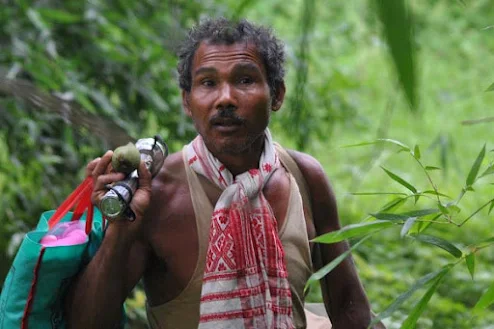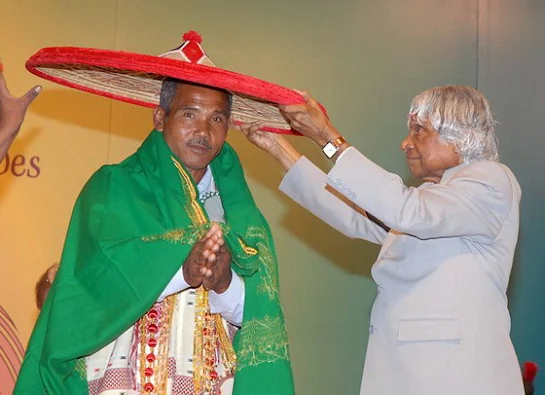Forest Man of India: Jadav Payeng
Remembering The Real Captain Planet of India
When I was a kid I used to watch The Animated Show Of "Captain Planet & Planeteers" Who used to save Planet Earth using Super Power which was granted to them by Mother Nature. But after coming across People like "Jadav Payeng Ji" I realized that You don't need any Super Power to save Mother Nature.
With only 50 bamboo saplings, 25 seeds, and a deep, enduring passion for the environment, Jadav Payeng began his 40-year mission to transform the fallow land of Majuli Assam into a thriving 550-acre biome.
The Man Who Grew A Forest Jadav Payeng, 62
Jadav "Molai" Payeng (born 1963) is an environmental activist and forestry worker from Majuli, popularly known as the Forest Man of India. Over the course of several decades, he has planted and tended trees on a sandbar of the river Brahmaputra turning it into a forest reserve. The forest, called Molai forest after him, is located near Kokilamukh of Jorhat, Assam, India and encompasses an area of about 1,360 acres / 550 hectares. In 2015, he was honored with Padma Shri, the fourth highest civilian award in India. He was born in the indigenous Mising tribe of Assam.
Jadav Payeng belongs to The Mising tribe in Assam, India. He lives in a small hut in the forest. Binita, his wife, and his 3 children (two sons and a daughter) accompany him. He has cattle and buffalo on his farm and sells the milk for his livelihood, which is his only source of income.
In 1979, Payeng, then 16, encountered a large number of snakes that had died due to excessive heat after floods washed them onto the tree-less sandbar. That is when he planted around 20 bamboo seedlings on the sandbar. He started working on the forest in 1979 when the social forestry division of Golaghat district launched a scheme of tree plantation on 200 hectares at Aruna Chapori situated at a distance of 5 km from Kokilamukh in Jorhat district. Molai was one of the laborers who worked on that project which was completed after five years. He chose to stay back after the completion of the project even after other workers left. He not only looked after the plants but continued to plant more trees on his own, in an effort to transform the area into a forest.
Knots of dead snakes had washed ashore, as the flooded Bramhaputra waters receded. As a teenaged Payeng walked the sun-baked shore, the sight of these snakes getting fried by the sun made him worry: What if this happens to people?
Payeng doggedly funneled his fears into transforming that fallow land into a 550-hectare, biome in Majuli, Assam—one tree at a time. “I started planting trees in 1979. The Deori community elders told me if I wanted to prevent snakes from dying, I should plant the world’s tallest grass. I didn’t know then; they meant bamboo. They gave me 50 bamboo seeds and 25 saplings, and that’s how this began.”
Payeng knew simply sowing a seed, didn’t mean it would sprout and thrive. The bamboo plants needed water. “I bought 50 earthen pots, poked holes in each, and used them to water the plants. I would go fill them up every five days.” As the waters of the Brahmaputra brought plants and seeds downstream and washed them ashore, Payeng would sift through the debris and plant them on the sandbar as well.
Soon, he was collecting seeds from the locals and planting them. “I have to acknowledge all the help I have gotten from my village. The elders have such an intimate relationship with the natural world and so much knowledge. They lived without disturbing the balance with nature. When I was struggling to keep my trees healthy, they told me that Amroli (red) ants can help. So, I would collect them in a sack and carry them to the sandbar. This is the kind of practical knowledge we need to pass on to our young.”
Payeng grew up around men who passed on a love for the environment and encouraged him. “As a kid, I used to be asked to plant paan during Bohag (April)—the ones I planted would always flourish. Not everyone can grow paan, you know,” he says. “I would get 25 paise per plant. Then, 25 paise would buy you 1.5 kgs of peanuts—I was motivated by that greed,” he says, laughing. One day, as he was on this errand a family friend took his hand, turned over his palm, and told him, his lines were auspicious. “He told me to continue this work for life and I would become someone good in life.”
Prophecy or not, Payeng—known to most by the nickname ‘Molai’—continues his work. Every day at dawn the 62-year-old sets out for his forest. Mola’r Forest—as the locals fondly call it in honor of its creator–caretaker—bursts with varied flora and fauna, including 1,000 deer, several species of migratory birds, and leopards. It’s also a refuge for rhinos during the region’s annual floods and an elephant corridor. He is currently working on a 200-hectare green cover, a project he started in 2011, with the help of the administration. “This will be done in 20 years,” he says.
After a 2010 news report brought him media attention, multiple awards and recognition followed. He was also awarded the Padma Shri in 2015. Payeng has recently signed an agreement with FundaciÓn Azteca, a Mexican non-profit organization, to collaborate on environmental work in the north-American country.
Having never expected fame, he says “I grew up loving nature—clear blue skies, tall trees, birds and animals. I tell everyone: It is not human beings who changed my life. It’s the trees that have put clothes on my back, birds who have taken me across seven seas, from the land where the sun rises first, to where the sun sets last.”
Jadav "Molai" Payeng (born 1963) is an environmental activist and forestry worker from Majuli, popularly known as the Forest Man of India. Over the course of several decades, he has planted and tended trees on a sandbar of the river Brahmaputra turning it into a forest reserve. The forest, called Molai forest after him, is located near Kokilamukh of Jorhat, Assam, India and encompasses an area of about 1,360 acres / 550 hectares. In 2015, he was honored with Padma Shri, the fourth highest civilian award in India. He was born in the indigenous Mising tribe of Assam.
The forest, which came to be known as Molai forest, now houses Bengal tigers, Indian rhinoceros, and over 100 deer and rabbits. Molai forest is also home to monkeys and several varieties of birds, including a large number of vultures. There are several thousand trees, including valcol, arjun (Terminalia arjuna), ejar (Lagerstroemia speciosa), goldmohur (Delonix regia), koroi (Albizia procera), moj (Archidendron bigeminum) and himolu (Bombax ceiba). Bamboo covers an area of over 300 hectares.
A herd of around 100 elephants regularly visits the forest every year and generally stays for around six months. They have given birth to 10 calves in the forest in recent years.
His efforts became known to the authorities in 2008, when forest department officials went to the area in search of 115 elephants that had retreated into the forest after damaging property in the village of Aruna Chapori, which is about 1.5 km from the forest. The officials were surprised to see such a large and dense forest and since then the department has regularly visited the site.
In 2013, poachers tried to kill the rhinos staying in the forest but failed in their attempt due to Molai who alerted department officials. Officials promptly seized various articles used by the poachers to trap the animals.
Molai is ready to manage the forest in a better way and to go to other places of the state to start a similar venture. Now his aim is to spread his forest to another sand bar inside of Brahmaputra.







Post a Comment
image quote pre code